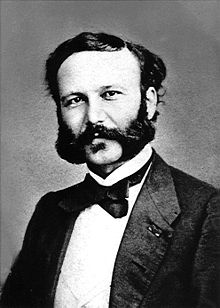คณะกรรมการกาชาดระหว่างประเทศ
คณะกรรมการกาชาดระหว่างประเทศ (อังกฤษ: International Committee of the Red Cross, ICRC; ฝรั่งเศส: Comité international de la Croix-Rouge, CICR) เป็นองค์กรมนุษยธรรมระหว่างประเทศ ซึ่งก่อตั้งขึ้นในประเทศสวิตเซอร์แลนด์เมื่อปี พ.ศ. 2406 โดยการนำของอ็องรี ดูว์น็อง มีสำนักงานที่นครเจนีวา ประเทศสวิตเซอร์แลนด์ ประเทศสมาชิกยอมรับให้เป็นองค์กรอิสระ ตามกฎหมายมนุษยธรรมระหว่างประเทศ (International humanitarian law) แห่งอนุสัญญาเจนีวา (Geneva Conventions) ซึ่งถือเป็นกฎหมายนานาชาติตามธรรมเนียม มีภารกิจทั่วโลกในการให้ความช่วยเหลือผู้ที่ได้รับผลกระทบจากการสู้รบและสถานการณ์ความรุนแรงอื่น ๆ ซึ่งรวมถึงผู้ที่ได้รับบาดเจ็บจากสงคราม ผู้ลี้ภัย เชลยสงคราม และพลเรือนที่ได้รับผลกระทบ
Comité international de la Croix-Rouge (ฝรั่งเศส) | |
 | |
| ก่อตั้ง | 9 กุมภาพันธ์ 1863 |
|---|---|
| ประเภท | องค์การนอกภาครัฐระหว่างประเทศ |
| วัตถุประสงค์ | คุ้มครองผู้เสียหายจากความขัดแย้งและให้ความช่วยเหลือ |
| สํานักงานใหญ่ | เจนีวา สวิตเซอร์แลนด์ |
| พิกัด | 46°13′39″N 6°08′14″E / 46.2274°N 6.1373°E |
ภูมิภาคที่รับผิดชอบ | ทั่วโลก |
| สาขาวิชา | มนุษยธรรมนิยม |
ประธาน | ปีเตอร์ เมาเรอร์ |
รองประธาน | ฌีล การ์บอนีเย |
ผู้อำนวยการ | รอแบร์ มาร์ดีนี |
งบประมาณ | 1576.7 ล้านฟรังก์สวิส (2016)[1] 203.7 ล้านฟรังก์สวิสสำหรับสำนักงานใหญ่ 1462.0 ล้านฟรังก์สวิสสำหรับศูนย์ประสานงาน |
พนักงาน | 15,448 คน (จำนวนพนักงานองค์การโดยเฉลี่ยในปี 2016)[2] |
| รางวัล |
|
| เว็บไซต์ | www |


การจัดตั้งสำนักงานของคณะกรรมการฯ นั้นขึ้นอยู่กับระดับของการสู้รบและสถานการณ์ความรุนแรงในพื้นที่นั้น ๆ ปัจจุบันคณะกรรมการฯ มีเจ้าหน้าที่ 11,000 คนปฏิบัติงานอยู่ในสำนักงานมากกว่า 80 ประเทศทั่วโลก สำนักงานใหญ่ของคณะกรรมการฯ ตั้งอยู่ที่นครเจนีวา ประเทศสวิตเซอร์แลนด์ โดยมีสำนักงานภูมิภาคกรุงเทพฯ ทำงานครอบคลุมประเทศไทย กัมพูชา ลาว และเวียดนาม
คนไทยจำนวนมากมักเข้าใจผิดว่าคณะกรรมการกาชาดระหว่างประเทศเป็นองค์กรเดียวกับสภากาชาดไทย และนิยมเรียกผิดว่าสภากาชาดสากล แต่คณะกรรมการกาชาดระหว่างประเทศ เป็นส่วนหนึ่งของกลุ่มองค์กรกาชาดและเสี้ยววงเดือนแดง (Movement of the Red Cross) เช่นเดียวกับสหพันธ์สภากาชาดและสภาเสี้ยววงเดือนแดงระหว่างประเทศ (International Federation of Red Cross and Red Crescent Societies) และ สภากาชาดและสภาเสี้ยววงเดือนแดง (National Societies) ของแต่ละประเทศ
ด้วยหลักการกาชาดและเสี้ยววงเดือนแดงที่เน้นการปฏิบัติงานอย่างเป็นอิสระ เป็นกลาง และไม่เลือกปฏิบัติ ทำให้เราสามารถปฏิบัติภารกิจในการช่วยเหลือและปกป้องชีวิตและศักดิ์ศรีของเหยื่อจากการสู้รบและสถานการณ์ความรุนแรงเหล่านั้นได้ โดยการติดต่อพูดคุยกับคู่กรณีและกองกำลังทุกฝ่าย รวมถึงกลุ่มติดอาวุธ เรื่องการให้ความเคารพต่อกฎหมายมนุษยธรรมระหว่างประเทศและกฎข้อบังคับขั้นพื้นฐานต่าง ๆ ในการปกป้องบุคคลที่อยู่ในสถานการณ์ความรุนแรง
คณะกรรมการกาชาดระหว่างประเทศ เป็นองค์กรที่เก่าแก่ที่สุดและทรงเกียรติในขบวนการกาชาด และเป็นหนึ่งในการบริหารองค์กรที่ขยายตัวมากที่สุด โดยได้รับรางวัลโนเบลสาขาสันติภาพถึง 3 ครั้งคือเมื่อ พ.ศ. 2460 พ.ศ. 2487 และ พ.ศ. 2506
ภารกิจของคณะกรรมการฯ
- การพยายามทำให้พลเมืองผู้ไม่มีส่วนเกี่ยวข้องกับการสู้รบและเหตุการณ์ความรุนแรงได้รับการละเว้นและปกป้อง
- เข้าเยี่ยมเชลยสงครามและผู้ต้องขังจากข้อหาความมั่นคง
- ส่งข้อมูลข่าวสารให้สมาชิกในครอบครัวที่ต้องพลัดพรากเนื่องจากการสู้รบ
- สืบหาผู้สูญหายอันเนื่องมาจากสงครามและความไม่สงบ
- ให้ความช่วยเหลือเบื้องต้นทางด้านการแพทย์
- จัดหาอาหาร น้ำสะอาด สาธารณูปโภคและที่พักพิงชั่วคราวแก่ผู้ประสบภัยจากสงคราม
- เผยแพร่กฎหมายมนุษยธรรมระหว่างประเทศ
- เฝ้าสังเกตการบังคับใช้เพื่อให้มีการปฏิบัติตามหลักกฎหมายมนุษยธรรมระหว่างประเทศ
- ช่วยผลักดันการพัฒนาข้อกฎหมายและอนุสัญญาต่าง ๆ ให้ทันต่อเหตุการณ์ปัจจุบัน
- ลดผลกระทบจากกับดักระเบิดและซากอาวุธอื่น ๆ ที่มีต่อผู้คน
- ให้การสนับสนุนการทำงานของสภากาชาดและสภาเสี้ยววงเดือนแดงเพื่อเตรียมรับมือกับสถานการณ์การสู้รบและความรุนแรงอื่น ๆ
ดูเพิ่ม
แก้อ้างอิง
แก้- ↑ "Annual Report 2016, Key facts and figures" (PDF). คลังข้อมูลเก่าเก็บจากแหล่งเดิม (PDF)เมื่อ 2020-08-14. สืบค้นเมื่อ 2022-02-19.
- ↑ "Annual Report 2016, Key facts and figures" (PDF). คลังข้อมูลเก่าเก็บจากแหล่งเดิม (PDF)เมื่อ 2020-08-14. สืบค้นเมื่อ 2022-02-19.
แหล่งข้อมูลอื่น
แก้หนังสือ
แก้- David P. Forsythe: Humanitarian Politics: The International Committee of the Red Cross. Johns Hopkins University Press, Baltimore 1978, ISBN 0-8018-1983-0
- Henry Dunant: A Memory of Solferino. ICRC, Geneva 1986, ISBN 2-88145-006-7
- Hans Haug: Humanity for all: the International Red Cross and Red Crescent Movement. Henry Dunant Institute, Geneva in association with Paul Haupt Publishers, Bern 1993, ISBN 3-258-04719-7
- Georges Willemin, Roger Heacock: International Organization and the Evolution of World Society. Volume 2: The International Committee of the Red Cross. Martinus Nijhoff Publishers, Boston 1984, ISBN 90-247-3064-3
- Pierre Boissier: History of the International Committee of the Red Cross. Volume I: From Solferino to Tsushima. Henry Dunant Institute, Geneva 1985, ISBN 2-88044-012-2
- André Durand: History of the International Committee of the Red Cross. Volume II: From Sarajevo to Hiroshima. Henry Dunant Institute, Geneva 1984, ISBN 2-88044-009-2
- International Committee of the Red Cross: Handbook of the International Red Cross and Red Crescent Movement. 13th edition, ICRC, Geneva 1994, ISBN 2-88145-074-1
- John F. Hutchinson: Champions of Charity: War and the Rise of the Red Cross. Westview Press, Boulder 1997, ISBN 0-8133-3367-9
- Caroline Moorehead: Dunant's dream: War, Switzerland and the history of the Red Cross. HarperCollins, London 1998, ISBN 0-00-255141-1 (Hardcover edition) ; HarperCollins, London 1999, ISBN 0-00-638883-3 (Paperback edition)
- François Bugnion: The International Committee of the Red Cross and the protection of war victims. ICRC & Macmillan (ref. 0503) , Geneva 2003, ISBN 0-333-74771-2
- Angela Bennett: The Geneva Convention: The Hidden Origins of the Red Cross. Sutton Publishing, Gloucestershire 2005, ISBN 0-7509-4147-2
- David P. Forsythe: The Humanitarians. The International Committee of the Red Cross. Cambridge University Press, Cambridge 2005, ISBN 0-521-61281-0
- Favez, Jean-Claude (1999). The Red Cross and the Holocaust. Cambridge, UK: Cambridge University Press. ISBN 0-521-41587-X.
- Dominique-D. Junod : "The Imperiled Red Cross and the Palestine Eretz Yisrael Conflict: The Influence of Institutional Concerns on A Humanitarian Operation." 344 pages. Kegan Paul International."@ The Graduate Institute of International Studies Geneva. ISBN 0-7103-0519-2 1995.
บทความ
แก้- François Bugnion: The emblem of the Red Cross: a brief history. ICRC (ref. 0316) , Geneva 1977
- Jean-Philippe Lavoyer, Louis Maresca: The Role of the ICRC in the Development of International Humanitarian Law. In: International Negotiation. 4 (3)/1999. Brill Academic Publishers, p. 503-527, ISSN 1382-340X
- Neville Wylie: The Sound of Silence: The History of the International Committee of the Red Cross as Past and Present. In: Diplomacy and Statecraft. 13 (4)/2002. Routledge/ Taylor & Francis, p. 186-204, ISSN 0959-2296
- David P. Forsythe: "The International Committee of the Red Cross and International Humanitarian Law." In: Humanitäres Völkerrecht - Informationsschriften. The Journal of International Law of Peace and Armed Conflict. 2/2003, German Red Cross and Institute for International Law of Peace and Armed Conflict, p. 64-77, ISSN 0937-5414
- François Bugnion: Towards a comprehensive Solution to the Question of the Emblem. Revised third edition. ICRC (ref. 0778) , Geneva 2005
แหล่งข้อมูลอื่น
แก้- International Committee of the Red Cross (ICRC)
- Legacy เก็บถาวร 2012-12-20 ที่ archive.today Dr. Cornelio Sommaruga, President of the ICRC from 1987-1999, donated four hours of high-definition audiovisual life story interviews to Legacy. The ICRC audiovisual library houses copies of these interviews.